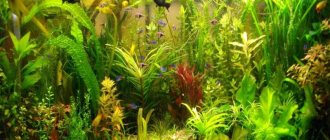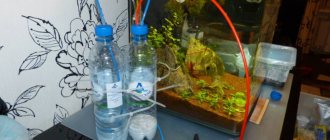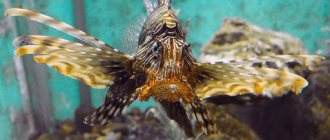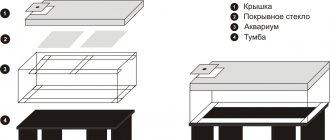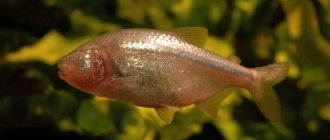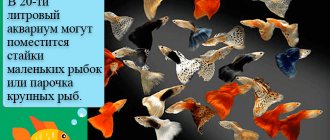Basic styles
There are several main styles in the design of reservoirs. But every aquarist is free to complement and improve the classic aquarium design at his own discretion with his own hands.
Dutch
The Dutch design style implies abundance and demonstrates an abundance of plants at all levels and levels of the reservoir.
The greatest attention is paid to filling the bottom part. In the center of the composition there should be a sufficient number of decorations with driftwood and stones.
However, not every tank exhibiting aquatic vegetation is called Dutch. For a body of water to be considered belonging to this style, it must obey certain rules:
- At least 80% of the bottom surface must be covered with plants, but no more than 10² cm is allocated for each type of algae.
- At least 10 varieties of plants are used in the design, and they must be combined with each other, forming a harmonious composition.
- Plants are placed in the reservoir in a terraced manner so that all types of plantings are clearly visible.
- For the smooth development of greenery, powerful lighting and excellent aeration are required.
- Fish and other inhabitants are not the main element of a Dutch aquarium. Plants will always come first, and this must be taken into account.
Pseudo-sea
This type of design is not intended for keeping marine fish , unlike a marine aquarium, but imitates the image of the ocean floor .
Cold blue lighting and a characteristic plot of stones and corals are used. It is acceptable to use a small amount of hardy algae and rocky soil. Wrecks of sunken ships and amphoras will perfectly complement the composition.
Try not to use natural shells to decorate your aquarium. They make the water hard, which is not suitable for most fish and plants. They are successfully replaced by plastic imitations.
Natural
Imagine an above-water landscape moved under the water column: this is how to beautifully decorate an aquarium in a natural style.
To understand how to properly design an aquascape, you need to focus on proportionality and a harmonious combination of landscape elements. The most commonly used are ground cover and narrow-leaved algae, mosses and ferns.
Collector's
The Dutch style design is not available to all aquarists due to its complexity. That is why a simplified model was created that allows you to create an imitation of a Dutch aquarium without complex planning of planting different types of plants.
fast-growing small-leaved algae are used in a collector reservoir and they wait until they cover the entire soil.
The recommended volume for this style is from 100 liters; in a smaller tank it will simply not be possible to appreciate the spectacular design.
Unforced Herbalist
The emphasis in the design is on the underwater flora . The greenery is allowed to grow naturally, giving the design the light and casual natural look of a natural body of water.
Boosted Herbalist
In this design, the viewer’s attention will also be focused on the plants , and the inhabitants of the reservoir will play the role of a background for the lush vegetation.
To stimulate the active development of plants, it is necessary to maintain the concentration of gases dissolved in water at a certain level and actively use complex mineral fertilizers.
Plot
The purpose of such a reservoir is to reliably reproduce a certain plot of a book , film or computer game.
Often, a pond decorated in the style of the baby’s favorite cartoon is used to decorate a children’s room.
Vanguard
This is a bright, unconventional body of water . It fits into unusual interiors with creative design, since artificial brightly colored plants, unusual soils and neon lighting .
Biotope
The biotope recreates the style of a certain natural reservoir , trying to convey its features as accurately as possible in an aquarium environment.
Japanese
Such reservoirs differ from other natural-style reservoirs. Their apparent simplicity hides the care with which each element occupies a place that is precise to the millimeter .
The design ideology is based on the principle of wabi-sabi (modest simplicity). To create such a reservoir, one strong point is used, which focuses the main attention on itself.
Such a pond with fish and plants is the quintessence of style and harmony; it personifies the fragile, fleeting beauty of our world and allows you to enjoy every moment of existence.
There are two stylistic groups in the Japanese design style:
- Iwagumi. The emphasis in this design is on the stones, repeating the style of the famous stone gardens.
- Rio boku. In this design, the main place is occupied by driftwood, while part of the decor can rise above the surface of the water.
Taiwanese
Synthesis of Dutch herbal and Japanese iwagumi. This is a unique natural reservoir that reproduces an element of the real landscape .
Antique
Such reservoirs use decor in the antique style : columns, amphitheaters, statues. The emphasis shifts from vegetation to decorative elements.
Lighting Features
Typically, mini-aquariums up to 40 liters in volume are sold with lighting already installed. But if you equip the tank yourself, you will have to spend time selecting and installing the right type of lamp. Among the features of nanoaquariums, one can note the installation of lighting not on the lid of the container, but above it at a certain distance. Fluorescent lamps are used as a lighting source with a power rating of 0.5 W per liter for unpretentious plants and 1 W for ground cover and some other types of flora. For LED backlighting, this indicator is measured in lumens - from 25 to 50 lm per liter.
It will not be possible to do without artificial lighting - most fish require much longer daylight hours than is available in Russian latitudes. In addition, even plants need additional lighting.
Aquascaping Ideas
Various techniques and means are used to decorate a reservoir, but before you start creating the interior, you need to take into account the design features for aquariums of different sizes.
50 liters
A small volume is suitable for a beginner aquascaper. To maintain such an aquarium, automated systems are used to purify water and supply it with oxygen , which greatly facilitates the care of the reservoir.
100 liters
This volume provides impressive scope for imagination , and there are an order of magnitude more options for designing the space.
In such a tank, both Dutch herbalism and Japanese minimalism are already appropriate.
200 liters
A 200 liter aquarium is considered an ideal platform for experimenting with design. The volume allows you to clearly zone the space , operate with large decorations or plant a large plant, and it is much easier to create a convincing biotope.
A paludarium in such a reservoir will also be much more impressive than in a small 100-liter aquarium.
Aquascaping in 100 liters
This volume of the vessel expands the boundaries of creativity. Here you can use different aquarium plants, decorating it in the Dutch style, or use a minimum of elements and create aquascaping in the style of an Iwagumi or Zen garden.
You can put a small artificial castle on the bottom of the aquarium
Home aquarium design option
For example, decoration with Eleocharis sp. "Mini" will create a soft lawn that does not grow and does not require regular mowing. You can also supplement the aquarium with a couple of stones and a driftwood with moss in the form of a bonsai. To do this, you can use Java moss, which is unpretentious in cultivation, and the only requirement for full growth is an established carbon dioxide circulation system. In dim light, Java moss will have an oblong shape and a light shade; in bright light, its texture will be denser, and its shape will be more compact and neat.
An aquarium with algae and pieces of wood will look very beautiful
You can put stones in the aquarium
The aquarium can be built into the interior opening
See alsoHouse facade decor: materials and technologies
Aquarium invertebrates
Some types of aquariums do not require the presence of fish , but this does not mean that you need to completely abandon the presence of fauna in the reservoir.
Invertebrates such as snails or shrimp can be an excellent alternative. They not only diversify the interior of the reservoir , but also help maintain the microclimate in it.
Paper fish for volume applique
- take note paper;
- fold the square diagonally. Cut the top of the triangle so that there is a semicircle on one side and a small angle on the other;
- straighten out a square of paper;
- cut the lines without reaching the end of the square;
- there should be a pair of strips - six or eight pieces;
- start “braiding” the strips; the intersection must be glued with glue. Glue the two inner strips and so on until you have joined the last two outer strips;
- Draw the eye and fin with a black felt-tip pen.
Make several fish from different colors in this way. Crafting an aquarium with fish will turn out to be varied if you add figures of other sea inhabitants to it.
Developing an action plan
It's a good idea to come up with a plan of action. Firstly, it is always easier to act according to plan. Secondly, you will have a list of necessary decorative elements and equipment .
Thirdly, having ready-made instructions for action, it is much easier to adapt to unexpected circumstances.
Filling procedure
It doesn’t matter in what style the work on designing the reservoir will be done - in order for it to function for a long time, there are a number of general rules for starting it up:
- At the time of filling the aquarium with decor and starting the aquarium, the fish should be kept in a separate small tank, undergoing quarantine before moving in.
- All decorative elements must be disinfected so as not to become a source of infection for living organisms.
- When all the necessary equipment is installed, you need to make sure that it is in working order.
- Let the filled reservoir sit for a week to form its own microclimate, and only after that introduce inhabitants into the aquarium.
Dimensions of small reservoirs and their purpose
Even the smallest fish aquarium should be equipped with the necessary devices:
- filter;
- aerator;
- heater;
- lighting.
The advantages of small tanks include the following:
- compactness;
- easy care;
- convenient transportation.
However, miniature reservoirs also have disadvantages. First of all, due to the small volumes, it is impossible to contain many inhabitants in the vessel. Secondly, the water in small aquariums gets dirty faster, so you will have to carefully monitor cleanliness and order. In tanks with a large volume, water changes are not as noticeable as in tiny ones, where any changes in environmental parameters lead to stress for the fish.
Popular articles How to make a Valentine card using isothread technique: 250+ photos, examples, as well as master classes and step-by-step diagrams
Small aquariums are divided into four types:
- Up to 5 l – suitable for interior decoration and planting. For example, only one tiny phenotype can be placed in a 2-liter aquarium, but experts recommend keeping such an aquarium without fish, because living in a cramped space makes pets feel discomfort. In addition, it is impossible to install equipment in such miniature reservoirs, so an aquarium without fish would be a humane solution.
- From 5 liters to 10 liters - a tank with such a displacement is also not entirely suitable for keeping living creatures. Of course, you can populate a tank with a school of zebrafish - the phenotype requires only one liter of water per individual, but you should remember about frequent cleaning, installation of equipment, without which the fish will die, and constant monitoring of water parameters. Therefore, experts also recommend keeping such an aquarium without fish.
- From 10 liters to 20 liters - in a reservoir of 10 liters or more you can easily place the necessary equipment and purchase beautiful and colorful fish, as well as plant lush and unpretentious green vegetation.
- From 20 liters to 50 liters - in an aquarium with such a displacement you can give free rein to your imagination, and have medium-sized fish, arrange instruments and decorations, creating underwater depths.
How to decorate an aquarium
You can complement the interior of the aquarium with different elements. The main thing is that they combine with each other and help create a single picture.
Background
A beautiful background is not only a decorative basis for the interior, but also a way to disguise unsightly tubes and boxes of filtration and aeration equipment.
Priming
Properly selected soil not only serves as a basis for plants, but also plays the role of a link between the background of the aquarium and its contents. In addition, it is the soil that helps highlight the beauty of the fish living in the reservoir.
Coral chips
Coral chips can be used in sea and pseudo-marine reservoirs as soil or to highlight a certain area on the bottom.
Driftwood and stones
to create interesting designs using improvised materials .
Plants
An integral part of the biosphere. In a small reservoir they help regulate the concentration of CO2, and in a large reservoir they create cozy shelters for the inhabitants of the aquarium.
Figures
Various decorative figures allow you to diversify the filling of the reservoir and correctly place accents.
Lighting
Lighting plays an important role in maintaining the functioning of the aquarium . But you need to carefully study the characteristics of fish and plants in order to select the power of the lighting lamps.
Filling procedure
There are several mandatory stages in the decorating process:
- choosing a design style or design development; the interior of the aquarium must be carefully planned; to create a sketch, you can use either a pencil with paints or graphic, including 3-D programs;
- purchasing or creating all design elements;
- processing of stones, wood and soil collected from nature; they need to be boiled with salt added and then washed;
- thorough washing of all purchased decor;
- backfilling soil into the aquarium;
- aquarium decoration;
- equipment installation;
- planting a plant;
- filling with settled water;
- colonization of fish and shellfish.
IMPORTANT: If you use sea corals for aquadesign, they should be placed only after all the inhabitants have settled.
If you were interested or have any questions, leave a comment!
Equipment - how to disguise
The issue of equipment camouflage is most acute in natural biotopes.
Partially, the problem can be solved by plants , which successfully hide tubes and wires, but the devices themselves have to be covered with large decorative elements (stones, driftwood or ruins of buildings, masterfully integrated into the interior).
